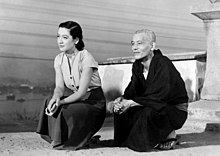User:Jlandis2/sandbox
History[edit]
The golden age of cinema in Japan started in the 1950s after the second World War. During the war, Japanese filmmakers were told to create propaganda films to make the people of Japan trust the Empire and glorify the war. With the tragic events at Hiroshima and Nagasaki, the interest of film decreased greatly in Japan. When the war ended, Douglas MacArthur went back to Japan. MacArthur was instructed to rebuild the country by showing the Japanese an American way of life. The reconstruction ultimately ended the Empire of Japan and created a foundation for what Japan would become today. In this reconstruction, MacArthur displayed a number films to demonstrate American life. The Japanese grew fond of these films which later influenced their films to be western and have characteristics of Hollywood narrative.
Rashomon[edit]

The kick starter to this golden age was Akira Kurosawa. Kurosawa was the director of the famous Rashomon. Rashomon helped shape to what the golden age of cinema would be like in Japan and would be one of the first modern film later on. Because Kurosawa was heavily influenced by Shakespeare and Westerns, Rashomon is considered to be a western and Japanese film since the film shows qualities of both genres. The film has close ups and movements of the camera audiences would see in Westerns, but Kurosawa uses natural contrast between light and dark with shadows to give Rashomon Japanese characteristics. The film shows a narrative of three main characters that contribute to the conflict based on two stories about Ryunosuke Akutagawa. The film has two times as many cuts than any average film but has aesthetically pleasing shots. Kurosawa wanted to recapture the beauty of silent films, and he does that with his famous forest scene where the camera pans to frame of filtered sun. By directly shooting into the sun, using the shadows of the forest, and mesmerizing camera movement of the forest ground, Kurosawa creates a natural feel in Rashomon. This styles can be described as formal strategies of decentering the gaze through [the directors] respective signatures of idiosyncratic editing, camera movement, and narrative structure. With their casual use of continuity editing Japanese filmmakers of the studio era designed textual strategies of narrative verisimilitude that were rarely focalized around a single character's point of view. [1]A major cultural influence Rashomon had on the rest of cinema was the development of unreliable character. Audiences began to question the memory and truths characters told in movies. Much later on, Rashomon would go on to influence Star Wars with characteristics like the audience questioning the main characters' truth and multiple narrators contributing to the plot.
Tokyo Story[edit]

A film that followed Rashomon was Tokyo Story directed by Ozu Yasujiro. Yasujiro allows the audience to feel a closeness with the characters by placing the camera low to the ground. For a majority of the film, the scenes are in intimate spaces on the ground at a table. Yasujiro thought it would only make sense to make the placement of the camera low enough to feel as if the audience was there as well. After the second world war, Yasujiro felt that Japan was modernizing too fast. In Tokyo Story, the camera remains perfectly still with little to no camera movement. In one scene with movement, a couple is looking out to the ocean on a wall. From the wall, the camera moves to frame the elderly couple. Tokyo Story is universally relatable in that it brings to light the unfortunate truths of living in a family: as children grow older they become busy with their own lives and neglect the people who love them. [2]This scene tells the audience to take a minute to slow down and digest everything that is going on. Ozu's tales of death and marriage such as Late Spring (1949) and Tokyo Story (1953) partake of a melodramatic mode that allegorizes tendencies in modern Japanese society toward the dissolution of the traditional household.[1] Ozu would later influence Hou Hsiao Hsien and Edward Yang who were filmmakers in Taiwan.
Other Major Filmmakers and Films[edit]
Other major films and filmmakers that came from this movement was Hiroshi Inagaki's Samurai 1: Musashi Minamoto in 1955, Kenji Mizoguchi's Ugetsu in 1954, Akira Kurosawa's Seven Samurai in 1954 and Throne of Blood in 1961, Kon Ichikawa's The Burmese Harp in 1956, and Ishirō Honda's Godzilla in 1954.

Modernism[edit]
The Golden Age of Japanese Cinema would go on to be the foundation of Modernism. Modernism would pick up characteristics like unity, multiple narrators, raise questions about uncovering the truth, disorientation of narrative line, and self-awareness storylines from Japanese films.
Video Clips and Stills[edit]
Rashomon: <iframe width="560" height="315" src="https://www.youtube.com/embed/GXygJmtnvm0" frameborder="0" allow="accelerometer; autoplay; encrypted-media; gyroscope; picture-in-picture" allowfullscreen></iframe>
- lens flare and natural contrast of shadows and light
Tokyo Story: <iframe width="560" height="315" src="https://www.youtube.com/embed/J_LXe4PIKtQ" frameborder="0" allow="accelerometer; autoplay; encrypted-media; gyroscope; picture-in-picture" allowfullscreen></iframe>
- camera placement
Propaganda during World War II: <iframe width="560" height="315" src="https://www.youtube.com/embed/bvLT8U0-_lI" frameborder="0" allow="accelerometer; autoplay; encrypted-media; gyroscope; picture-in-picture" allowfullscreen></iframe>
References[edit]
- Russell, Catherine. "Japanese Cinema in the Global System: An Asian Classical Cinema." China Review, vol. 10, no. 2, 2010, pp. 15-36. ProQuest, https://ezproxy.saddleback.edu/login?url=https://search.proquest.com/docview/873186802?accountid=39855.
- Hanrahan, Ryan. “Tokyo Story: Storytelling Through Cinematography and Pacing.” Zoltn Grossman, 21 Jan. 2016, sites.evergreen.edu/eyeofthestory/tokyo-story-storytelling-through-cinematography-and-pacing/.
- Maher , Michael. “Japan's Influence on Cinema After WWII.” The Beat: A Blog by PremiumBeat, 13 Sept. 2015, www.premiumbeat.com/blog/japans-influence-on-cinema-after-wwii/.
- Sloves , Samuel. “CTVR5 Week 6.1.” 27 Dec. 2018.
- Prince, Stephen. “The Rashomon Effect.” The Criterion Collection, 7 Nov. 2012, www.criterion.com/current/posts/195-the-rashomon-effect.
- Desser, David. “Japan.” Film Reference, www.filmreference.com/encyclopedia/Independent-Film-Road-Movies/Japan-THE-SECOND-GOLDEN-AGE.html.
- Iwamoto, Kenji. “The Aesthetics of Japanese Cinema.” RAIZO, www.raizofan.net/eng/jpncinema.htm.
- Komatsu, Hiroshi. "The Foundation of Modernism: Japanese Cinema in the Year 1927." Film History, vol. 17, no. 2, 2005, pp. 363-375. ProQuest, https://ezproxy.saddleback.edu/login?url=https://search.proquest.com/docview/219816189?accountid=39855.
- ^ a b Russell, Catherine (Fall 2010). "Japanese Cinema in the Global System: An Asian Classical Cinema". login.ezproxy.saddleback.edu. Retrieved 2018-12-14.
- ^ "Tokyo Story: Storytelling Through Cinematography and Pacing |". Retrieved 2018-12-17.

